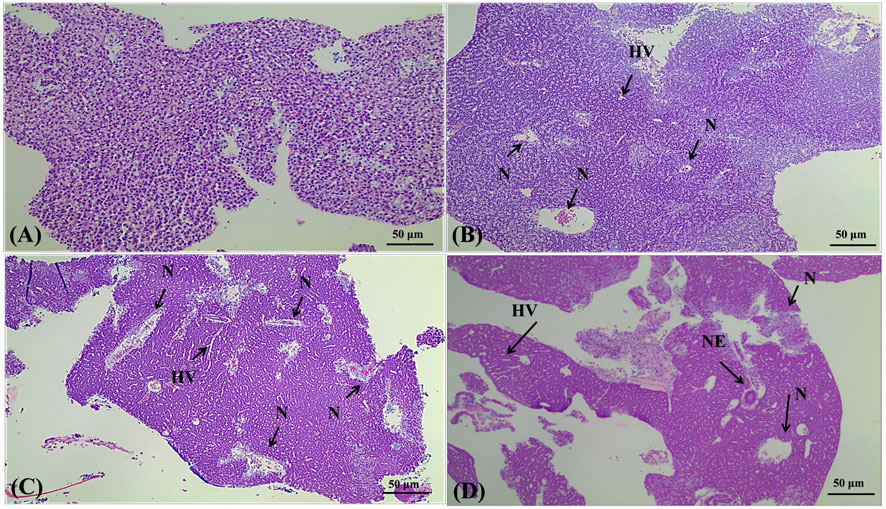
94% of researchers rate our articles as excellent or good
Learn more about the work of our research integrity team to safeguard the quality of each article we publish.
Find out more
CORRECTION article
Front. Physiol., 19 August 2022
Sec. Environmental, Aviation and Space Physiology
Volume 13 - 2022 | https://doi.org/10.3389/fphys.2022.1000714
This article is part of the Research TopicEnvironmental Pollutant and Oxidative Stress in Terrestrial and Aquatic OrganismsView all 6 articles
This article is a correction to:
Biomarker Responses, Gene Expression Alterations, and Histological Changes in Zebrafish (Danio rerio) After In Vivo Exposure to Polychlorinated Diphenyl Ethers
by Ye C, Xiong W, Shi S, Shi J, Yang W and Zhang X (2022). Front. Physiol. 13:907906. doi: 10.3389/fphys.2022.907906
In the published article, there was an error in Figure 6 as published. The incorrect image for Figure 6D was used. The corrected Figure 6 appears below.

FIGURE 6. Effects of 4,4′-di-CDE exposure on histology of the liver of zebrafish after 14 days of exposure Lights micrographs of sections through the liver of zebrafish showing the histological structure od the control group(A) and animals treated with 1 (B), 10 (C), and 50 μg/L (D) 4,4′-di-CDE, respectively. Samples were stained with hematoxylin and eosin and photomicrographs were taken using ×100 magnification. N-Nuclei Necrosis, HV-hepatocyte vacuolation, NE-Nuclear Enlargement.
The authors apologize for this error and state that this does not change the scientific conclusions of the article in any way. The original article has been updated.
All claims expressed in this article are solely those of the authors and do not necessarily represent those of their affiliated organizations, or those of the publisher, the editors and the reviewers. Any product that may be evaluated in this article, or claim that may be made by its manufacturer, is not guaranteed or endorsed by the publisher.
Keywords: polychlorinated diphenyl ethers, oxidative stress, histological changes, integrated biomarker response, endocrine disrupting effects
Citation: Ye C, Xiong W, Shi S, Shi J, Yang W and Zhang X (2022) Corrigendum: Biomarker responses, gene expression alterations, and histological changes in zebrafish (Danio rerio) after in vivo exposure to polychlorinated diphenyl ethers. Front. Physiol. 13:1000714. doi: 10.3389/fphys.2022.1000714
Received: 22 July 2022; Accepted: 28 July 2022;
Published: 19 August 2022.
Edited and reviewed by:
Paola Venditti, University of Naples Federico II, ItalyCopyright © 2022 Ye, Xiong, Shi, Shi, Yang and Zhang. This is an open-access article distributed under the terms of the Creative Commons Attribution License (CC BY). The use, distribution or reproduction in other forums is permitted, provided the original author(s) and the copyright owner(s) are credited and that the original publication in this journal is cited, in accordance with accepted academic practice. No use, distribution or reproduction is permitted which does not comply with these terms.
*Correspondence: Jiaqi Shi, c2hpamlhcWlfamlheW91QDE2My5jb20=; Xuesheng Zhang, emhhbmdxaW5nODcyNUAxNjMuY29t
†These authors have contributed equally to this work and share first authorship
Disclaimer: All claims expressed in this article are solely those of the authors and do not necessarily represent those of their affiliated organizations, or those of the publisher, the editors and the reviewers. Any product that may be evaluated in this article or claim that may be made by its manufacturer is not guaranteed or endorsed by the publisher.
Research integrity at Frontiers

Learn more about the work of our research integrity team to safeguard the quality of each article we publish.